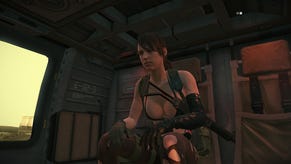Metal Gear Solid V: The Phantom Pain PlayStation 4 Review: All Good Things [Update: Now With a Score]
Kojima's final turn with the series is also his most ambitious, but how well does it come together?
This article first appeared on USgamer, a partner publication of VG247. Some content, such as this article, has been migrated to VG247 for posterity after USgamer's closure - but it has not been edited or further vetted by the VG247 team.
Hideo Kojima has never been what you would call a conservative designer. From the very start, he strained against the limitations of the medium, often with brilliant results. But with Metal Gear Solid V: The Phantom Pain, Kojima has taken a different approach. For what will almost certainly be Kojima's final turn with the series, he has thrown the proverbial kitchen sink into The Phantom Pain, producing what is easily the most expansive game in the series.
I've been playing MGS V for about 40 hours now, and I'm still not quite finished. Some of that is pure content - there are more than 40 missions in the story alone, and that doesn't include the large numbers of side ops. Some of that is due to the often frustrating difficulty spikes that crop up when the Skulls arrive - an enemy that you will come to fear and hate as the story progresses. But for better or worse, there's no denying that Metal Gear Solid V is a huge game; one that is basically on par with a fairly long RPG.
Ostensibly an open world game dotted with bases and guard posts that you can explore at your leisure - you can drop in to Afghanistan or Africa at any time and just ride around on your horse if you wish - Metal Gear Solid V is primarily structured around its missions. These operations, which typically involve rescuing a hostage or eliminating a target, are very similar to Ground Zeroes - the prologue that served as a paid demo for The Phantom Pain. They are essentially puzzles with multiple solutions that encourage you to experiment with the many tools at your disposal. Sometimes you will find yourself pulling off the perfect heist, which is thrilling. More often than not, though, you will find yourself saying "eff it" and pulling out your rocket launcher, which can be satisfying in its own way.
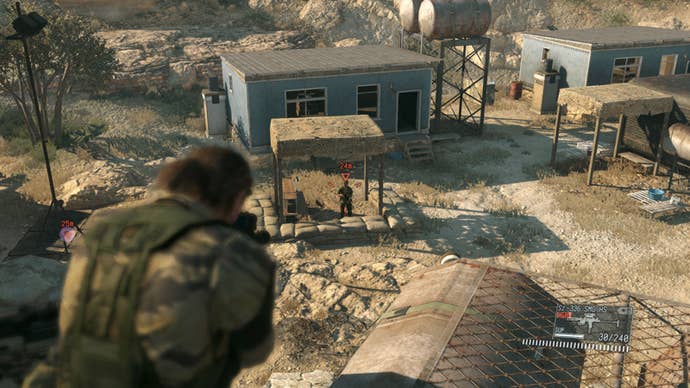
In structuring The Phantom Pain the way he has, Kojima has more or less created a direct successor to Peace Walker, which was a compelling game in its own right but greatly limited by the fact that it was developed for the PSP. That approach has its advantages and its disadvantages. The open-ended nature of the missions can be quite fun, but the relatively non-descript bases and airfields suffer in comparison to Shadow Moses and Groznyj Grad - compelling settings that were almost characters in their own right. They also teeter on the brink of being overly samey, which is something Metal Gear Solid V spends its duration fighting against.
There are a few things that keep it from plummeting completely into the abyss of repetition. The most significant is Mother Base - Big Boss's headquarters and easily the most enjoyable location in the game. Set on a drilling platform resembling that of Sealand, it serves as a visual representation of your progress through the game, steadily growing as you earn the money and resources to build new platforms. Strictly speaking, there's not a lot you can actually do at Mother Base outside of visit certain characters, but you will nevertheless find yourself returning often, if only to shower off all the blood and muck that accumulates when you're out in the field - one of the many delightful details that serves to set Metal Gear Solid V from other big-budget action games.

Outside of being a cool setting in its own right, Mother Base is also where you earn new tools, making it doubly valuable. There's a continuous flow of volunteers into Mother Base throughout the game who are automatically assigned to whichever department they are best suited, whether it's intelligence, R&D, the medbay, or whatever else. In addition, you can capture enemy soldiers and send them back to Mother Base, where they can be flipped to your side. One of Metal Gear Solid V's most enjoyable challenges is in capturing rather than killing an enemy commander and adding them to your ranks, which is very much in line with Metal Gear's tradition of rewarding non-lethal solutions to problems. They in turn can raise the level of a particular department, unlocking new weapons and items for later missions. In that, building up Mother Base is a crucial part of Metal Gear Solid V, and a rewarding one at that. With so many new recruits and weapons being constantly unlocked after every missions, the game rarely loses momentum, except during its more frustrating missions.
Another way in which Metal Gear Solid V manages to avoid becoming repetitive is in its well-paced dispersal of its setpieces. In that, Kojima proves that he is still one of the best directors around, his best scenes bringing with them a level of intensity that other triple-A action games struggle to conjure. It's evident from the very first minutes of the game, when a critically injured Snake awakens from a coma to find himself in the midst of a bloody massacre, forced to hide among the bodies while gunmen probe through the hallway with their automatic weapons. It's a harrowing sequence that sets the tone for the rest of the game, with plenty more like it to be found as the story continues, often at the most unexpected moments.

Interestingly enough, there aren't many boss battles in Metal Gear Solid V. You'll find them here and there, but from what I've played thus far, few of them are on par with anything you'll find in Snake Eater or even the original Metal Gear Solid. There's the typical sniper duel, and there's a rather cool sequence in which you have to find a way to stop an implacable foe who resembles a fire demon, but such moments are rare. Having said that, there is a rather large fight in the back half of the game that will make Metal Gear Solid fans equal parts happy and frustrated.
I suppose I would also be remiss if I didn't mention the Skulls - supernatural commandos who pop up to menace Snake at the worst possible moments. Skulls are absurdly tough, extremely fast, and capable of dealing out huge amounts of damage, making them bosses in their own right. Their encounters also constitute some of the most frustrating moments in the game. When the time comes to finally stand your ground and fight them, you will find them nearly invincible to anything outside of a homing missile. The mist they bring with them makes visibility poor at best. You will learn to hate seeing the Skulls under the "Special Guest" credits that roll before each mission - a typical Kojima touch that makes Metal Gear Solid V out to be a kind of television show while hinting at what you will have to prepare for. In terms of the actual gameplay, they are probably the single element I like least about Metal Gear Solid V.
Frustrating as it can be, though - and Metal Gear Solid V can be really frustrating - there's never been a point where I've actually wanted to stop. On the contrary, I had to be practically dragged away from one particular boss fight that had been giving me fits for what seemed like hours. It's a compulsive experience that compels you to assign your new staff, develop some weapons, then move on to your next mission. In that, Metal Gear Solid V rarely feels like it's a 50 hour game, though there's no denying its scope.
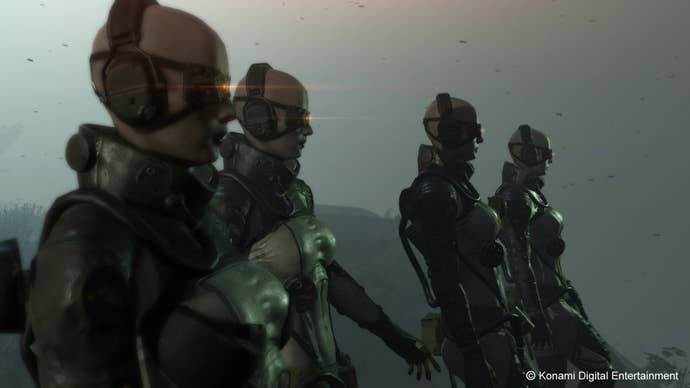
Its biggest strength continues to be Kojima's mastery of individual details, which are evident in every facet of the game. When you climb into your helicopter to leave the battlefield, for example, the mission doesn't just end. Instead, Snake will sit on the edge for a while as the battlefield below steadily recedes before finally climbing in and shutting the door. If one of his support characters is with him, they'll be hanging out with him. Photographs proliferate on the walls of the chopper. Snake's wolf - called D-Dog - exhibits almost Pixar-like levels of detail in the way it moves and interacts with the characters, and is easily the best dog I've seen in a video game to date. You can even find and listen to cassette tapes containing '80s pop tunes like "The Final Countdown" and "Rebel Yell" - a detail that must have cost Konami a small fortune in licensing fees. In the end, though, it's worth it for the way that it adds further color to an already incredibly rich setting.
InterfaceZooming in with the R1/RB button can be a tad cumbersome, but otherwise the controls work very well. The myriad menus flow well and are easy to understand.
Lasting AppealThe Phantom Pain runs a minimum of 45 to 50 hours, putting it on part with a pretty long RPG. It's a huge and comprehensive package.
SoundThe soundtrack is mostly subdued, but it does a great job of using musical beats and sound effects to warn you of an enemy's approach. The '80s pop tunes are a hilarious (and welcome) addition.
VisualsMetal Gear Solid 5 sets a new benchmark for this console generation with its graphics. The character models in particular are stunning.
ConclusionThe story loses a lot of momentum in the back half, and F.O.Bs aren't much more than a fun novelty, but otherwise it's a stunningly enjoyable game that almost perfectly integrates a sizable open world environment with solid stealth fundamentals and a huge arsenal. Even at its most frustrating, it's an incredibly absorbing play. We'll be talking about this one for a long time to come.
How Well Does Metal Gear Solid V's Traditional Formula Mix With An Open World Environment?
Every time a really strong new stealth action game comes around, critics inevitably rush to bury Metal Gear Solid. As the series that did the most to popularize the genre, it's naturally the most common touchstone for critics.
In some ways, Metal Gear Solid V is not that different from what it's been since the days of the PlayStation. The basics of crawling, looking around corners, and quietly disposing of guards is much the same as before. In other ways, it's very different. Good scouting, for instance, is more important than ever, aided by your trusty binoculars and the Intel team back on Mother Base, who will pass along reports and suggestions as the missions progresses. Likewise, capturing and interrogating guards is essential, as they are the ones who will clue you in to the presence of powerful guards, hostages, or items.
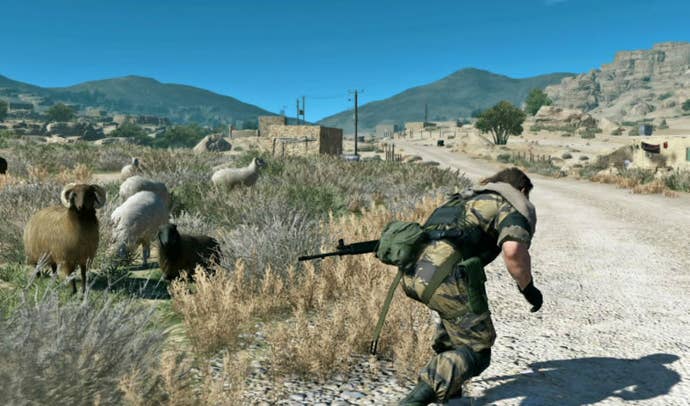
It's been possible to interrogate guards for a while now, of course. But in Metal Gear Solid V, the fog of war obscures everything. Earlier, I likened it to a puzzle; and in that light, the guards are useful for offering clues to the solution. Once I figured out that I needed to interrogate everyone possible, I had a much easier time.
When it comes to actually capturing a guard, Snake has plenty of tools at this disposal. Over the course of The Phantom Pain, you can unlock the usual array of pistols, assault rifles, sniper rifles, and explosives, as well as more exotic fare like decoy mines that will draw away enemies. As usual, you can tranquilize foes with a silenced pistol; but after a while, I eschewed the tranquilizer for a normal pistol. When a guard is on the verge of ratting you out, sometimes all you can do is shoot them in the face.
In addition to the rather large array of weapons at your disposal, it's also possible to customize them with silencers and other accessories, though it's a feature that's quite easy to miss. It's only possible to access it by completing certain Side Ops, and it's up to you to find them yourself (admittedly, it's not too hard to figure out that you should probably try and rescue someone called The Legendary Gunsmith). The rewards for opening up weapon customization are quite high. If you want a sniper rifle with tranquilizers, that's how you get it.
In encouraging you to experiment with both lethal and non-lethal methods for disposing of enemies in a stealthy manner, The Phantom Pain is very much in keeping with the tradition of Metal Gear. And by expanding the scope of the battlefields, it further sharpens that sense of experimentation. It's a game where you'll spend a lot of time talking about how you tackled a particular mission. Everyone is apt to have a different solution, as well as a different sticking point.

As long as I'm on the topic of sticking points, it's only fair to go further Metal Gear Solid V's difficulty spikes, which I discussed in my initial write-up on Monday. Put simply, there are times when I feel like The Phantom Pain's mission design is problematic. For instance, one of my least favorite missions involves scouting three Russian commanders who are coming into town for a meeting. They arrive at separate times from separate locations, and if you kill them piecemeal, the meeting will instantly be called off. Thus, it's best to track them until they enter a random building in the village, where they are quickly surrounded by a mass of guards. I spent what seemed like hours banging my head against that mission, finally resorting to sneaking into the building where they were meeting before they arrived, knocking them out, and sneaking them out for extraction. True, I probably could have just sniped them, but that was the most ham-fisted solution. I really wanted to get rid of them without alerting the entire village.
I complain about that mission in particular because it's emblematic of how razor thin the margin for error can be in Metal Gear Solid V. Even in the early missions, there are often a huge number of soldiers and traps to navigate, and alerting any one of them to your presence has a very good chance of getting you killed. In that regard, the somewhat controversial "reflex mode" - a mechanic that slows time dramatically when you get caught so you can get in a headshot - is actually quite welcome. It means that if you mess up, you're not instantly screwed, which is nice because the checkpoints in Metal Gear Solid V tend to be pretty far apart. Mess up, and you'll have to infiltrate your objective all over again, which can get agonizing at times. Success requires a certain degree of mastery over the mechanics and a huge amount of patience, which are in many ways virtues, but doesn't change the fact that it occasionally makes me want to put my controller through the screen.
In the end, beating a mission in Metal Gear Solid V is an intricate process. You have to carefully scout out your location, gather information, devise a plan, and finally make your move. When it works, it really works, and it's thrilling, especially when you succeed. At its worst, though, it can feel like an overly punitive obstacle course that you have to run through over and over again until you get it exactly right. I suppose that is also in keeping with Metal Gear Solid tradition in some ways. I also remains one of the few games that will actually make me feel like a failure for resorting to pulling out my rocket launcher and going to town.
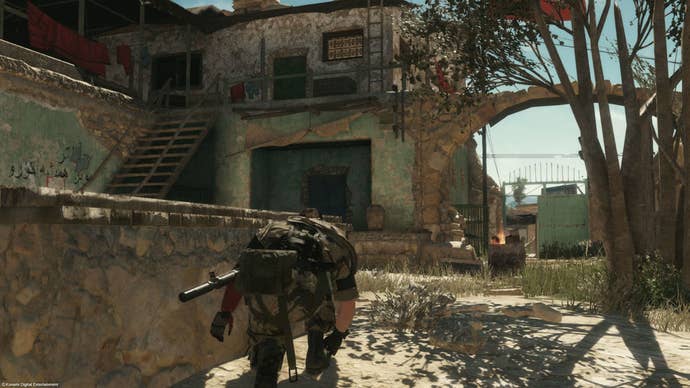
All in all, I think Metal Gear Solid's traditional stealth mechanics mesh rather well with its semi-open world environment. With so much equipment and vehicles at your disposal, as well as companions like D-Dog who can distract foes or even take them out, there's no shortage of options for accomplishing your objective while toying with the guards. I don't think it's fair to say that the old formula was getting stale, but the more expansive setting definitely gives it a shot in the arm. And absent some of my problems with the balance of the level design, I'd say Metal Gear Solid V does a fine job of making sure the potential of its setting is realized.
InterfaceZooming in with the R1/RB button can be a tad cumbersome, but otherwise the controls work very well. The myriad menus flow well and are easy to understand.
Lasting AppealThe Phantom Pain runs a minimum of 45 to 50 hours, putting it on part with a pretty long RPG. It's a huge and comprehensive package.
SoundThe soundtrack is mostly subdued, but it does a great job of using musical beats and sound effects to warn you of an enemy's approach. The '80s pop tunes are a hilarious (and welcome) addition.
VisualsMetal Gear Solid 5 sets a new benchmark for this console generation with its graphics. The character models in particular are stunning.
ConclusionThe story loses a lot of momentum in the back half, and F.O.Bs aren't much more than a fun novelty, but otherwise it's a stunningly enjoyable game that almost perfectly integrates a sizable open world environment with solid stealth fundamentals and a huge arsenal. Even at its most frustrating, it's an incredibly absorbing play. We'll be talking about this one for a long time to come.

Even During a Stealth Mission, F.O.B!
I couldn't resist make the reference. Every time I hear F.O.B in The Phantom Pain - short for Forward Operating Base - I think of that wonderful song about Etrian Odyssey. It's even halfway appropriate, since you never know when you're going to get an emergency alert informing you that your F.O.B. is under attack.
The F.O.B. becomes available around halfway through the game, and is ostensibly there to serve as a jumping off point for additional operations. Contrary to early reports from GameSpot, the first F.O.B. is free - microtransactions only come into play if you want additonal bases. Once you have an F.O.B., you can start attacking bases belonging to other players, which will earn you money and potentially valuable soldiers for Mother Base.
In most cases, you will work your way through an opposing F.O.B. like you will any other base, killing and extracting enemy soldiers on the way to the installation's core. Sometimes, though, an actual player will drop in to try and stop you, at which point the battle becomes an exciting cat and mouse battle through the multi-level F.O.B. In such instances, MGS V takes on the tension and excitment of a Dark Souls duel, though the battles in The Phantom Pain tend to end much more quickly.
It's obvious that F.O.Bs are meant to be a big part of the Metal Gear Solid V experience. They are carefully introduced in the context of the story, receive a lengthy tutorial, and offer plenty of rewards. And yet, after building my F.O.B. and dabbling in a few battles, I found myself going offline and not looking back. Once the novelty had worn off, all the pop-ups and prompts felt like a distraction. What's more, being online slowed the menus considerably, though that was likely a product of the servers being hammered on launch day. I haven't lacked for resources while playing offline, so I haven't missed them.
Best case scenario, Konami irons out the menu lag and a PvP community develops around F.O.B. combat. If that winds up being the case, then the F.O.B. will prove a compelling addition to Metal Gear Solid V. But for the most part, I found it easy to ignore.
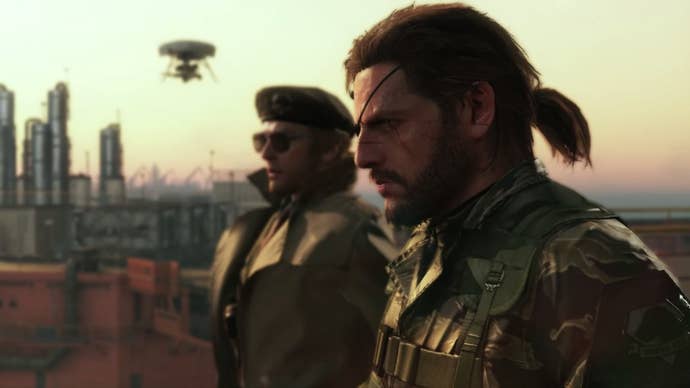
Final Thoughts: Does Metal Gear Solid V Stick the Landing?
When I was about 30 hours into Metal Gear Solid V, I wrote how impressed I was by its ambition. The question is: Does it stick the landing? I'm on the fence about that.
When all is said and done, I think Hideo Kojima took the right approach in structuring The Phantom Pain as he did. Don't get me wrong, I love the craft of Snake Eater, but it sort of feels like Kojima has done everything there is to be done with the traditional Metal Gear Solid formula. It's always nice to see a creator take some risks, especially when it's carried off this well.
Perhaps the biggest risk of all comes in the back third of the game - a kind of coda that wraps up the arcs for a number of key characters. It intersperses a handful of story missions with replay challenges, with the rest of the story hidden away behind secret objectives. There's a "true ending" with a pretty unbelievable twist in there, and if you want the true Metal Gear Solid V experience, it's worth going through the trouble to unlock. If you don't, the story hits a climax and sort of peters out in a depressing fashion.
It's an odd but fitting approach for what is in many ways Kojima's wildest story yet, at times pushing beyond the realms of science fiction and into something akin to magic. There is a "practical" explanation for the Skulls, Quiet's special abilities, and the fire demon who appears in the opening moments, but it's one that requires some serious suspension of disbelief. And in typical Kojima fashion, the secret is there to bonk you over the head with big ideas, particularly the notion that war turns even the best of intentions to s**t.
The thing is, Metal Gear Solid V has a very large budget, which affords it a lot of handsomely produced cutscenes. And as always, characters like Ocelot are extremely welcome. It's tough to get much further into the story without venturing into some serious spoiler territory - that goes double for Quiet - but absent the filler, it mostly works. As always, Big Boss is the game's most compelling figure, his presence serving to ground even the wackiest ideas in something approaching reality.
The hardest thing about writing this review is that Metal Gear Solid V defies an actual score. I can point out the occasional bouts of repetition and filler, but there's no question that it is a masterfully executed game that will figure heavily into this year's Game of the Year discussions. Even at its most annoying, when you die deep in an enemy base and have to wind all the way through its defenses again, it's undeniably absorbing. It makes you want to try your best. If this is truly Kojima's swan song, then it is a terrific end to a distinguished career. Something tells me he's not done, though. If The Phantom Pain is any indication, he still has a great deal to contribute to gaming. I look forward to seeing what's next.
InterfaceZooming in with the R1/RB button can be a tad cumbersome, but otherwise the controls work very well. The myriad menus flow well and are easy to understand.
Lasting AppealThe Phantom Pain runs a minimum of 45 to 50 hours, putting it on part with a pretty long RPG. It's a huge and comprehensive package.
SoundThe soundtrack is mostly subdued, but it does a great job of using musical beats and sound effects to warn you of an enemy's approach. The '80s pop tunes are a hilarious (and welcome) addition.
VisualsMetal Gear Solid 5 sets a new benchmark for this console generation with its graphics. The character models in particular are stunning.
ConclusionThe story loses a lot of momentum in the back half, and F.O.Bs aren't much more than a fun novelty, but otherwise it's a stunningly enjoyable game that almost perfectly integrates a sizable open world environment with solid stealth fundamentals and a huge arsenal. Even at its most frustrating, it's an incredibly absorbing play. We'll be talking about this one for a long time to come.








